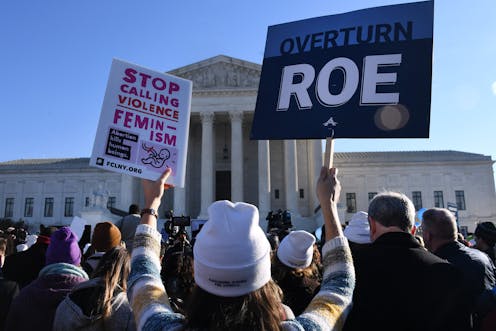
Tens of thousands of anti-abortion protesters are expected to descend on Washington on Jan. 21, 2022, for the March for Life rally – as they have done annually since 1974 to protest the Roe v. Wade ruling of the previous year.
Whether they have reason to march against abortion in 12 months’ time is uncertain, though. It will likely depend on how the Supreme Court decides the case Dobbs v. Jackson Women’s Health Organization, which deals with a Mississippi law that bans most abortions in the state after the 15th week of pregnancy.
Speculation about the justices’ anticipated decision, expected by June, seems to be less about whether they will eviscerate the Roe decision – which recognized a constitutional right to abortion without excessive government interference – and more about how they might do it.
Prior to justices taking up Dobbs, much of the commentary on how the Court would deal with abortion was that it would kill Roe quietly, bit by bit, in a series of piecemeal rulings. But after oral argument on Dec. 1, 2021, a swift and unambiguous overturning is now thought possible.
In that December hearing, lawyers arguing the case and several justices discussed the criteria for overturning established precedent, which is a rule of law created by an earlier case. They referenced some of the “great overrulings” in the Court’s history, citing 1954’s Brown v. Board of Education – which ended legal racial segregation in public schools – as the greatest of them all.
As a legal scholar, I know that the Brown decision was of huge consequence. But it wasn’t the simple overruling that many see it as today. The care taken by the justices in 1954 in making that landmark ruling might have lessons for the current justices’ forthcoming decision in Dobbs.
‘Dramatic shift’
The precedent that Brown supposedly overruled was Plessy v. Ferguson, the 1896 Supreme Court ruling that created the “separate but equal” doctrine enforced throughout the Jim Crow era.
Plessy held that the Fourteenth Amendment’s requirement of equal protection was satisfied by providing facilities of equal quality – in Plessy, it was railroad cars – even when citizens were segregated by race.
In Brown, the Supreme Court came down unanimously in favor of ending public school segregation. But many have assumed that in so doing the justices ruled that Plessy had been wrongly decided and decisively overturned it.
Chief Justice John Roberts asserted as much in his own confirmation hearings in 2005. When asked if the Court broke new ground in Brown, he replied: “Of course it was a dramatic shift. And the overruling of Plessy v. Ferguson was exactly that.”
But I believe the Brown decision was actually far more subtle. A careful reading shows that it did not overrule Plessy. Rather, it followed and applied Plessy rigorously.
The Court determined that separating children in public schools on the basis of race in and of itself harmed minority children psychologically.
A famous footnote in Brown cited social science studies in support of that factual finding.
And that finding of harm was crucial. It meant that racial segregation of public school children could never be “separate-but-equal,” as required by Plessy:
“We conclude that in the field of public education the doctrine of ‘separate but equal’ has no place. Separate educational facilities are inherently unequal. Therefore, we hold that the plaintiffs and others similarly situated … are, by reason of the segregation complained of, deprived of the equal protection of the laws guaranteed by the Fourteenth Amendment.”
The Court ruled that the moment the government places those children into separate schools, no matter how equal the physical facilities and educational services, the minority children are being excluded, made to feel inferior, and thereby harmed. In short, it failed Plessy’s test.
The Brown ruling did not overturn Plessy. It did not even carve out an exception to Plessy.
Instead, it followed Plessy and its logic to arrive at the conclusion that segregated public schools flunked the separate-but-equal test. Nothing more. The day after Brown was announced, Plessy was still standing.
Destroying precedent … by following it
The justices in Brown were doubtless aware of the virulent racism that existed in parts of the U.S. and the controversy around segregation. They were aware that some Americans would violently resist legally mandated desegregation.
If they were going to begin the process of desegregating America, they knew they had to do it with a minimum of swagger and a maximum of respect for precedent.
But the lesson of Brown is not, or not only, to try to minimize violent reaction. More important for the Court and the law, it is that judges who set out to change the future might be more effective if they can avoid ripping up the past.
Narrow though the Brown ruling was, it provided what Constitutional law expert Justin Driver described as “a powerful rhetorical and moral weapon that helped to catalyze the nation toward the goal of racial equality.” Brown was cited in subsequent years to help advance the proposition that segregation of other kinds was also unconstitutional – even though Brown itself said no such thing – and its impact expanded and spread.
Brown eventually destroyed Plessy – not by overruling it, but by following it.
Could today’s justices be as ingenious as their predecessors in Brown, and find a subtle and deferential way to bring about the sweeping legal change they might have in mind, while still respecting well-established precedent? We soon shall see.
[Understand key political developments, each week. Subscribe to The Conversation’s politics newsletter.]
Michael J. Saks has donated to the American Civil Liberties Union and to candidates for various public offices.
This article was originally published on The Conversation. Read the original article.







